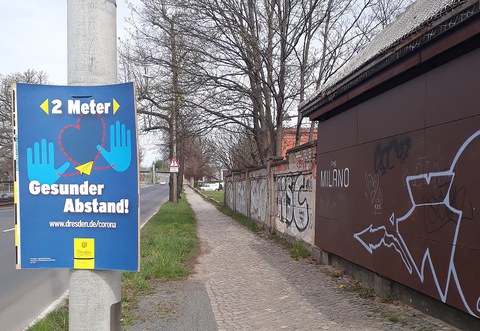14.07.2020
How planning for child friendly cities helps addressing the COVID-19 pandemic

Poster by the City of Dresden raising awareness to keep a "healthy" distance of 2 meters due to Covid-19, while the sidewalk does not allow pedestrians to keep such a distance.
Throughout Europe, Metamorphosis (http://www.metamorphosis-project.eu/) has so far implemented over 300 measures that make neighbourhoods child friendly. These measures contribute to physical activity and active mobility by, among others, redistributing urban space to the benefit of children and people in general – as opposed to cars. Planning public space for children could also help reducing the rate of infection and the mortality of a COVID-19 infection in all age groups.
In recent decades, cities have focused on planning for cars. The majority of urban public space was given to individual motorised transport discouraging active mobility. By focusing on designing cities for children instead, urban planning can affect the COVID-19 pandemic in two ways. Firstly, by stimulating active modes of transport. It has been shown that active mobility is related to a variety of non-communicable diseases, such as cardiovascular disease, cancer as well as type two diabetes and an increased BMI (Baumann et al., 2017; Patterson et al., 2020; Smart, 2018). At the same time, the growing prevalence of the above mentioned diseases due to a lack of active mobility aggravates the effects of COVID-19 infections. Among others, these diseases are listed as underlying medical conditions associated with an increased risk of a severe COVID-19 disease process (ECDPC, 2020).
The second leverage point for children friendly urban planning is the distribution of space. As a communicable disease, COVID-19 is getting transmitted through droplets from the nose or mouth, travelling between individuals being close to each other. To reduce the risk of infection, the WHO (2020) recommends to keep a distance from at least one meter between two persons. Urban space designed for children allows for implementing these recommendations, because space will be (re)distributed to people.
Author: Jan Peter Glock
References
Bauman, Adrian E.; Grunseit, Anne C.; Rangul, Vegar; Heitmann, Berit L. (2017): Physical activity, obesity and mortality: does pattern of physical activity have stronger epidemiological associations? In: BMC public health 17 (1), S. 788. DOI: 10.1186/s12889-017-4806-6.
European Centre for Disease Prevention and Control: COVID-19 surveillance report. Week 25, 2020. Online available https://covid19-surveillance-report.ecdc.europa.eu/.
Patterson, Richard; Panter, Jenna; Vamos, Eszter P.; Cummins, Steven; Millett, Christopher; Laverty, Anthony A. (2020): Associations between commute mode and cardiovascular disease, cancer, and all-cause mortality, and cancer incidence, using linked Census data over 25 years in England and Wales: a cohort study. In: The Lancet Planetary Health 4 (5), e186-e194. DOI: 10.1016/S2542-5196(20)30079-6.
Smart, Michael J. (2018): Walkability, transit, and body mass index: A panel approach. In: Journal of Transport & Health 8, S. 193–201. DOI: 10.1016/j.jth.2017.12.012.
World Health Organization: How does COVID-19 spread? Online available https://www.who.int/emergencies/diseases/novel-coronavirus-2019/question-and-answers-hub/q-a-detail/q-a-coronaviruses.
